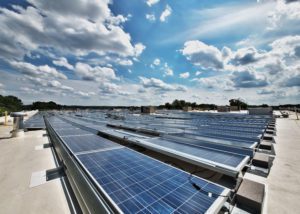If you consider that the recent worldwide 10-year average annual growth rate for solar energy production has been almost 46% , it seems like a good time to jump in and become an ‘energy prosumer’. In my last post, I described how an electrical energy storage system (EESS) can help you make the most out of your onsite energy generation resources. It does this by increasing the flexibility of how and when you’re able to use the energy you generate, especially from renewables like solar, wind, or CHP. This, in turn, helps maximize self-consumption of that energy when it’s most advantageous, including during a blackout. It also helps you reap the full benefits of smart grid programs like demand response or advanced tariffs, because you’ll have more options for dynamically adapting your load profile. So, simply storing the energy you produce makes that energy far more valuable. More valuable for you, and for the grid operator or commercial aggregator that wants to pay you for reducing your load or injecting energy back onto the grid.
New technologies are now making it possible to have a purpose-built, EESS installed within your facility, whether you’re operating an office building or an industrial plant. If creating this kind of microgrid sounds interesting to you, there are a few things you should consider when researching the options.
Playing it smart on the smart grid
First, it’s one thing to have a lot of stored energy at your disposal, but you also need to be confident you’re making the best decisions about how to use it. There can be a lot influences on when it might be most economical to charge your batteries, consume that energy, or save it to use later. You should look for an energy storage system that gives you added intelligence, through integration with a data acquisition and analysis solution. This will not only make you aware of your generation and storage capacity, but it should also be tracking your facility’s load profile, as well as weather forecasts and the variable market price of electricity. All of these factors will play into your decision making, in combination with being aware of production schedules, critical processes, and non-critical loads that offer you and the grid some flexibility.
Next, if you’re interested in participating in a demand response program, you’ll need a way to efficiently communicate with the entity managing that program, typically an aggregator. This interaction is often enabled through a web portal of some kind. Ideally this platform should be tightly integrated with your EESS and other energy assets, as it needs to present a real-time summary of your available energy resources. It also needs to quickly alert you to requests from your energy provider, which could include an opportunity to be paid to reduce your total energy consumption for a specific period of time, or maybe to sell stored energy to the grid. The system should give you a clear and actionable roll-up of information about your energy assets and processes that will make it easy for you to accept or reject each offer.
Finally, if you’ve made the decision to accept an offer you need to take action. Ideally, you’ll want some help with that. The most comprehensive approach is to implement a smart ‘gateway’ that integrates with your EESS, as well as your various building, process, and power distribution automation systems. This should give you a range of pre-configured, safely-coordinated actions that you can choose from, with varying degrees of load reduction, load increase, or delivered energy from your storage system.
Big, green batteries for your green energy
Just as using renewable energy production will help reduce your carbon footprint, choosing the right batteries will also minimize your environmental impact. Look for an EESS with batteries that offer a strong recycling program, ideally 100% of their parts. And look for high efficiency and low self-discharge rate, which translates to minimal wasted energy. Lithium-ion is a technology that can typically deliver on these requirements.
It’s important to consider the present as well as the future. An EESS should be flexible enough to suit your specific application, but also have the ability to easily grow with your needs, in terms of capacity.
And, of course, safety and reliability are primary considerations. You should look for a proven track record of compliance with standards, and safe handling procedures when replacing or adding batteries. The system should be designed for a long life, require minimal regular maintenance, and offer a complete battery management system that includes monitoring, alarms, logging, and diagnostics to ensure everything keeps going under any demanding conditions.
Next time we’ll talk about the types of services you can expect to support your electrical energy storage system. This includes the steps to get your system up and running, as well as applications and programs to complement your prosumer strategy and leverage your EESS over the long term.
If you’re reading this during the first week of June, come meet our experts at the Smart Grids Paris conference from June 4th to 6th. We’ll be happy to talk with you about electrical energy storage systems and other smart grid solutions.


